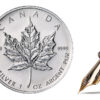Canadian gold exports rose 2.5 per cent in April from March, reaching new all-time highs by volume and even surpassing levels set before the COVID-19 pandemic.
Statistics Canada said on Monday that the export numbers were driven by metal and non-metallic mineral products, which were up 13.6 in April.
Unwrought gold exports saw a 46 per cent rise due to higher volumes and prices.
According to Statistics Canada, the growing demand for Canadian gold products indicates economic uncertainty as investors tend to prefer safe-haven metals like gold and silver. The increase in exports was mainly driven by Canadian financial institutions transferring more gold assets to the United States.
Despite the Bank of Canada’s tightening of interest rates since March 2022, the widening trade surplus is a clear indication that Canada’s economy remains robust.
Last week, the central bank surprised the markets by raising its key interest rate by 25 basis points to 4.75 per cent, the highest level since 2001.
In April, the consumer price index (CPI) inflation in Canada increased to 4.4 per cent, marking the first rise in 10 months. This increase was driven by higher prices for a wide range of goods and services, surpassing expectations. Despite lower energy costs, inflation in goods prices went up. Meanwhile, inflation in services prices remained high, reflecting strong demand and a tight labor market.
Read more: Canada braces for mild recession amid US downturn and inflation: Deloitte report
Read more: Gold is still the best hedge against inflation: NevGold CEO
Bank of Canada expects inflation to ease to 3% in the summer
The Bank of Canada anticipates that CPI inflation will ease to around 3 per cent during the summer. This is expected to occur as lower energy prices start to have an impact, and the substantial price gains observed last year are no longer factored into the yearly data. However, concerns have emerged due to three-month measures of core inflation consistently ranging between 3.5 per cent and 4 per cent for several months. Additionally, the persistence of excess demand has raised worries that CPI inflation could remain significantly above the target of 2 per cent.
Previously, it was expected that the rates would remain unchanged after the central bank’s pause in the two previous consecutive meetings. In justifying its decision to further tighten monetary policy in June, the central bank pointed to persistently high inflation, stronger-than-anticipated economic growth, and a tight labor market.
The central bank’s statement on Wednesday explained that the increase in the policy interest rate was necessary because the current monetary policy was not restrictive enough to bring supply and demand into balance and achieve sustainable inflation at the 2 per cent target. The governing council of the central bank stated that it will continue to evaluate the dynamics of core inflation and the outlook for CPI inflation.
.














